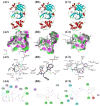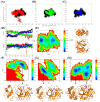Molecular Insights into Structural Dynamics and Binding Interactions of Selected Inhibitors Targeting SARS-CoV-2 Main Protease
- PMID: 39769245
- PMCID: PMC11677904
- DOI: 10.3390/ijms252413482
Molecular Insights into Structural Dynamics and Binding Interactions of Selected Inhibitors Targeting SARS-CoV-2 Main Protease
Abstract
The SARS-CoV-2 main protease (Mpro, also known as 3CLpro) is a key target for antiviral therapy due to its critical role in viral replication and maturation. This study investigated the inhibitory effects of Bofutrelvir, Nirmatrelvir, and Selinexor on 3CLpro through molecular docking, molecular dynamics (MD) simulations, and free energy calculations. Nirmatrelvir exhibited the strongest binding affinity across docking tools (AutoDock Vina: -8.3 kcal/mol; DiffDock: -7.75 kcal/mol; DynamicBound: 7.59 to 7.89 kcal/mol), outperforming Selinexor and Bofutrelvir. Triplicate 300 ns MD simulations revealed that the Nirmatrelvir-3CLpro complex displayed high conformational stability, reduced root mean square deviation (RMSD), and a modest decrease in solvent-accessible surface area (SASA), indicating enhanced structural rigidity. Gibbs free energy analysis highlighted greater flexibility in unbound 3CLpro, stabilized by Nirmatrelvir binding, supported by stable hydrogen bonds. MolProphet prediction tools, targeting the Cys145 residue, confirmed that Nirmatrelvir exhibited the strongest binding, forming multiple hydrophobic, hydrogen, and π-stacking interactions with key residues, and had the lowest predicted IC50/EC50 (9.18 × 10-8 mol/L), indicating its superior potency. Bofutrelvir and Selinexor showed weaker interactions and higher IC50/EC50 values. MM/PBSA analysis calculated a binding free energy of -100.664 ± 0.691 kJ/mol for the Nirmatrelvir-3CLpro complex, further supporting its stability and binding potency. These results underscore Nirmatrelvir's potential as a promising therapeutic agent for SARS-CoV-2 and provide novel insights into dynamic stabilizing interactions through AI-based docking and long-term MD simulations.
Keywords: Bofutrelvir; Paxlovid; SARS-CoV-2; Selinexor; artificial intelligence; molecular interactions.
Conflict of interest statement
The authors declare no conflicts of interest.
Figures










Similar articles
-
Exploring epigenetic drugs as potential inhibitors of SARS-CoV-2 main protease: a docking and MD simulation study.J Biomol Struct Dyn. 2024 Aug;42(13):6892-6903. doi: 10.1080/07391102.2023.2236714. Epub 2023 Jul 17. J Biomol Struct Dyn. 2024. PMID: 37458994
-
In Silico Comparative Analysis of Ivermectin and Nirmatrelvir Inhibitors Interacting with the SARS-CoV-2 Main Protease.Biomolecules. 2024 Jun 25;14(7):755. doi: 10.3390/biom14070755. Biomolecules. 2024. PMID: 39062468 Free PMC article.
-
AI-driven covalent drug design strategies targeting main protease (mpro) against SARS-CoV-2: structural insights and molecular mechanisms.J Biomol Struct Dyn. 2025 Jul;43(11):5436-5464. doi: 10.1080/07391102.2024.2308769. Epub 2024 Jan 29. J Biomol Struct Dyn. 2025. PMID: 38287509 Review.
-
Repurposing FDA-approved drugs for COVID-19: targeting the main protease through multi-phase in silico approach.Antivir Ther. 2024 Dec;29(6):13596535241305536. doi: 10.1177/13596535241305536. Antivir Ther. 2024. PMID: 39639531
-
Recent Advances in SARS-CoV-2 Main Protease Inhibitors: From Nirmatrelvir to Future Perspectives.Biomolecules. 2023 Sep 2;13(9):1339. doi: 10.3390/biom13091339. Biomolecules. 2023. PMID: 37759739 Free PMC article. Review.
Cited by
-
Investigating the Post-Mortem Risk of Transmission of SARS-CoV-2 Virus in Cadaveric Tissues: A Systematic Review of the Literature.Microorganisms. 2025 Jan 27;13(2):284. doi: 10.3390/microorganisms13020284. Microorganisms. 2025. PMID: 40005651 Free PMC article. Review.
-
In silico screening of naturally derived dietary compounds as potential butyrylcholinesterase inhibitors for Alzheimer's disease treatment.Sci Rep. 2025 May 17;15(1):17134. doi: 10.1038/s41598-025-98092-y. Sci Rep. 2025. PMID: 40382441 Free PMC article.
References
-
- Singh M., Jayant K., Singh D., Bhutani S., Poddar N.K., Chaudhary A.A., Khan S.U., Adnan M., Siddiqui A.J., Hassan M.I., et al. Withania somnifera (L.) Dunal (Ashwagandha) for the possible therapeutics and clinical management of SARS-CoV-2 infection: Plant-based drug discovery and targeted therapy. Front. Cell Infect. Microbiol. 2022;12:933824. doi: 10.3389/fcimb.2022.933824. - DOI - PMC - PubMed
MeSH terms
Substances
Grants and funding
LinkOut - more resources
Full Text Sources
Research Materials
Miscellaneous

